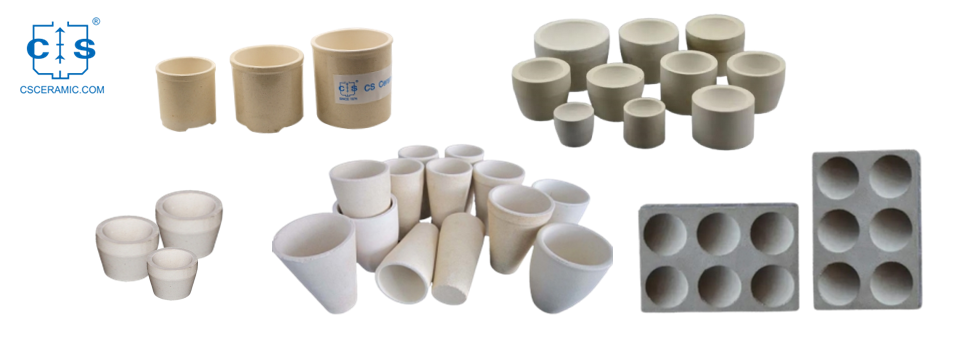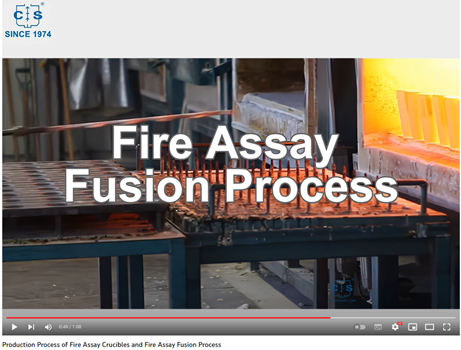Fire Clay Crucible丨Assay Crucible丨Cupellation Crucible
Modern fire assay crucibles differ from those of the past in that they are created specifically for laboratory use, with exacting specifications and a strong resistance to huge temperature fluctuations, which they may experience during multiple uses.
What is a fire assay crucible used for?
A fire clay crucible is a specialized container made from a mixture of fire clay and other refractory materials. It is designed to withstand extreme temperatures and can be used for melting, refining and analyzing metals and minerals.
The crucible is used in fire assay furnaces to melt and analyze samples of ore, metal alloys and other minerals. The crucible is able to withstand temperatures reaching up to 1400 °Cand can contain the sample during the heating and cooling process. The crucible is typically made of a mixture of clay and other refractory materials and is a crucial tool in the refining and analysis of metals and minerals.
![]() Click the video to view 'Production Process of Fire Assay Crucibles and Fire Assay Fusion Process'
Click the video to view 'Production Process of Fire Assay Crucibles and Fire Assay Fusion Process'
Shape and Size
The shape, size and material of Industrial Crucibles are determined by the application for which they are designed. They can vary from as small as a teacup to tremendous containers that can hold several tons. The different shapes for crucibles are barrel-shaped, conical/tapered, cylindrical, wide-form and high-from, and the materials including bone ash, fire clay and magnesium oxide can be chosen.

Usage
A crucible is employed in the initial stage of the fire assay fusion process. Generally, the steps are as follows:
The crucible is filled with a flux and sample combination, which is mixed together. It is then heated to more than 1000 °C in a furnace. After a specified amount of time, the molten material is poured into a cast iron mould. After cooling, the crucible is ready for reuse; however, if the sample contained a large amount of gold, it should be disposed of instead.
Selecting Furnaces
The type of furnace and heating method must be taken into account when selecting the material for your crucible. If the furnace has a slow heating rate, the crucible should be designed with materials that have high thermal conductivity in order to capture energy efficiently. Some of the types of furnaces used are:
Fuel Fired,Electric Resistance,Induction,Pit Furnace.
Factors that will Affect Your Crucible Parameters
The design of the crucible depends on the application it is being used for. Laboratories typically employ removable crucibles with an "A" shape, which can be taken out of the furnace using tongs. On the other hand, factories usually use fixed crucibles. The material you are working with and the size of your sample should be taken into consideration when selecting your crucible design. Factors that will affect what your crucible parameters will be include:
- The capacity, dimensions, and type of furnace used
- The alloys to be melted
- Melting and holding temperatures
- The temperature change rate
- Fluxes used
- The process of eliminating slag
Fire Assay Method
The fire assay method is the most dependable way of determining the presence of precious metals like gold, silver, or platinum in ore.
The fire assay crucible is an essential tool for the fire assay process, which has been used to accurately determine the gold content for over three thousand years. This method is divided into three separate steps, and is still the most reliable testing procedure today.
1. Melting.
The sample is placed in a crucible along with fire assay flux. This is then put into a fusion furnace, where the lead captures the gold, silver, and other precious metals in the molten state, forming a lead alloy (generally referred to as a "lead button"). As the lead alloy has a high specific gravity, it will sink to the bottom of the crucible. The base metals, oxides, and gangue in the sample will then react with the fluxes (silica, borax, and sodium carbonate), forming slags (silicates or borates) that have a low specific gravity and therefore float on the surface of the crucible. This ultimately allows the gold and silver to separate from the sample.
2. Cupellation
A cupel should be heated to an appropriate temperature to remove lead from the lead alloy. During this cupellation process, the lead will be converted to lead oxide, which will be absorbed by the porous ashtray. This will leave a button of gold, silver and other precious metals, which will not be oxidized and will remain in the cupel as particles.
3. Partition
Nitric acid can be used to break down the gold-silver composite particles, allowing the silver to dissolve while the gold stays solid. After the reaction is finished, the gold particles can be measured to determine their weight. Knowing the weight of the gold, the content of silver can be determined through the difference in quality between the original gold-silver composite particles and the gold particles.
Thank you for reading. We invite you to visit CSCERAMIC for more information if you would like to learn more about industrial ceramic material and the advanced range of ceramic products we offer.




 info@csceramic.com
info@csceramic.com








 +86 18273288522
+86 18273288522